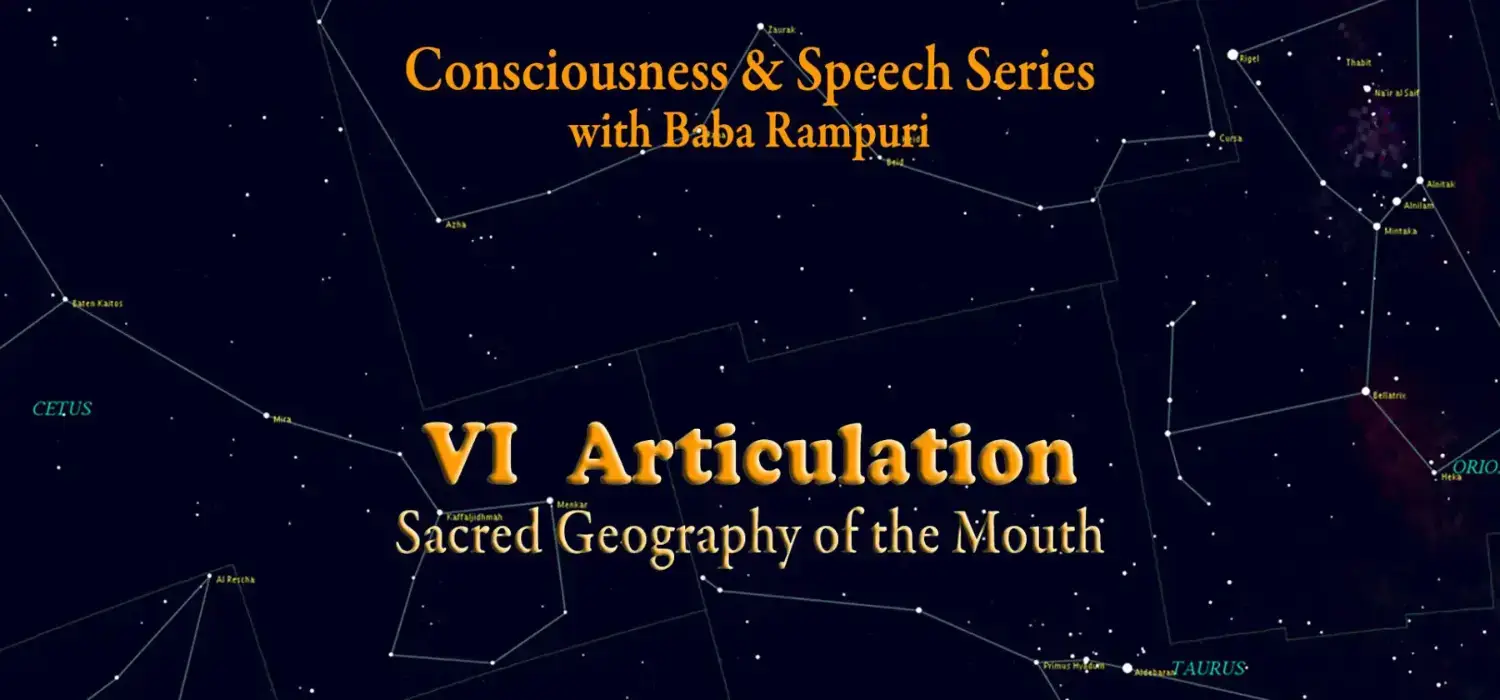
Sacred Geography of the Mouth part 1
Sacred Speech Masterclass episode VI
part 1 of 5 parts
hosted by Baba Rampuri
![]()
Articulation
We start the conversation with the parable of the desire of Shiva, Lord of Consciousness, to know Himself. When he sees his reflection, it is that of Shakti. We discuss the mystical significance of vowels and consonants, vowels as “lingas,” and consonants as “yonis.”
![]()

![]()
Baba Rampuri: What I thought I would start with is a parable that I think some of you may have heard me use before. I have certainly written it several times. It may even be in my first book. I don’t remember at this point. But there are some basic differences which are not really differences in the end.
But, differences that, if we’re aware of them, the operation with speech becomes more accessible. So, it’s the parable of Shiva, who for our purposes, is the Lord of Consciousness and we can think of as pure unmoving, unmanifested, consciousness Itself.
And there’s a certain moment in a timeless space, in which Shiva wants to know himself. He has the desire to know who He is. And so in this parable what He does is picks up a mirror and He looks at himself in the mirror and in the mirror He sees Shakti, he sees Pavarti, he sees the Mother Goddess, and he exclaims, “Aah.”
What’s happened here is that we have Shiva, the subject, and since Shiva wants to know himself, the only way you can know something is for that something to be the object of knowledge. Shiva wants to create this objective self, which is the Mother Goddess, which is the manifestation of consciousness, the growing of consciousness, and at first in potential and then finally the manifestation of the world itself.
This is a kind of paradigm that is going to break down all the way through speech and all the way through the syllables.
So in order for us to get a good handle on what I am addressing, this an idea of speech that is different from a scientific paradigm, for a moment, I would like us to forget about what how we think of letters, and alphabets, sounds, and so forth and think of our vocal apparatus, the way that we create speech, or the way we manifest, sorry, but not the way that we create speech, but the way that we manifest speech, if we think of this almost as a map, keeping in mind that the map that is not the thing, the map is a representation of that thing. So we will visualize our vocal apparatus as this kind of map.
Now, the first thing that we should be aware of is that there is a very basic difference of two categories of articulations that we make. And by the way please interrupt me if you want any clarification or if you have questions. There are two basic categories in our articulation. We have vowels and we have consonants.
In traditional Indian phonetics, grammar and speech, a consonant is described as something that is struck, but not just struck, struck very specifically struck in a very specific place. This is a consonant.
A vowel, on the other hand, is a svara in Sanskrit, which means “to be sounded.” Vowels are sounded. And vowels are very similar to Shiva as the subject. In other words, vowels really require consonants. Vowels can be sounded on their own, but vowels require consonants to manifest themselves, to expand themselves, to have a life, as it were.
Consonants, on the other hand, which in Sanskrit are called vyanjan means “manifesting.” So, consonants are basically impotent. They are nothing without a vowel. Now the reason that I asked you to forget for the moment about letters and alphabets and so forth is because we think very often of letters and alphabets as in terms of the names of the letters, “A,” “B,” “C,” “D,” “E” and so forth. In the Indian system, the names are the actual sounds, but in terms of a consonant, since you cannot pronounce, articulate consonants on their own without a vowel. In other words, “Ka,” we know “Ka” from the vowel “a.” That gives a definition to this “Ka” sound that we can’t make without the vowel. It’s the vowel becomes almost like the soul of the consonant. And, for that reason, interestingly enough, the consonants are called yonis, shakta-yonis, because it is from these consonants that the world is going to manifest and expand.
Is everybody with me so far? Yes? OK. The consonants, actually the consonants and the vowels, are articulated from 5 different stations and in 4 different ways.
One of the very fascinating aspects of Indian languages and Sanskrit is the fact that there is a systematic alphabet as it were as opposed English, and Cyrillic and the Western languages which are pretty much arbitrary. The fact that “A” is at the beginning and “Z“, or “Zed” is at the end is and the order of the letters that go in between is pretty much arbitrary. But in Sanskrit and in Indian language there is no arbitrariness in terms of the order that we give to the vowels and the consonants.
Now, the 5 stations of articulation, interestingly enough, also relate to densities, and densities relate to the five elements.
So, as we discussed before, we have a most dense element, which is earth. And then a slightly less dense element which is water. And then an even less dense element which is fire. Even less which is air. And then finally the least dense of all the elements is space. And we find that we have the same thing or we have an analogy of this in our speech.
![]()